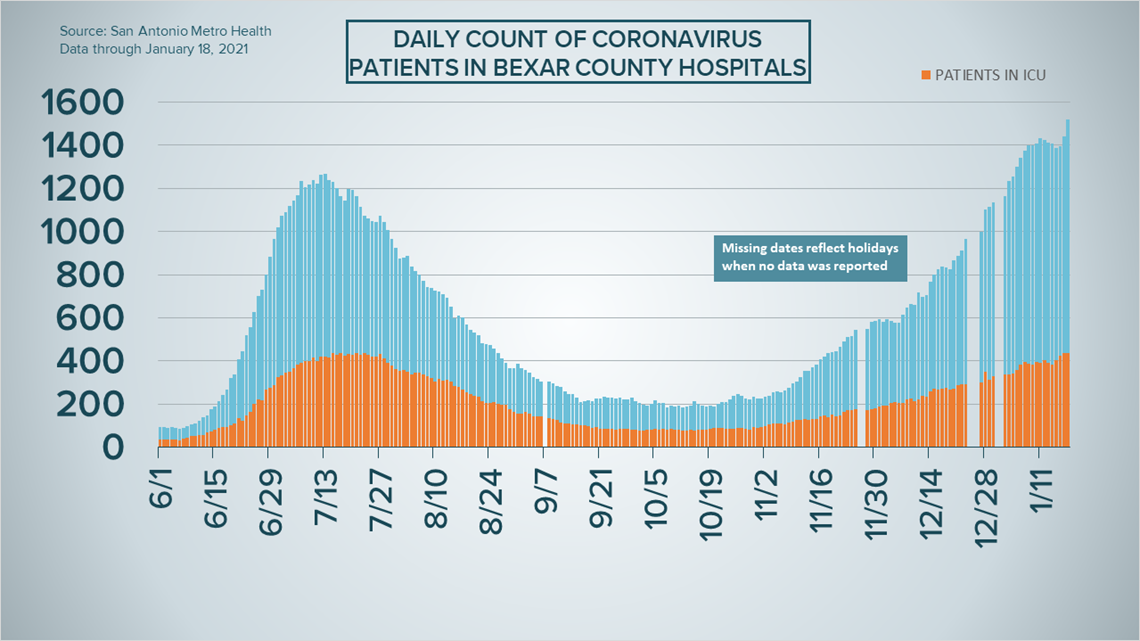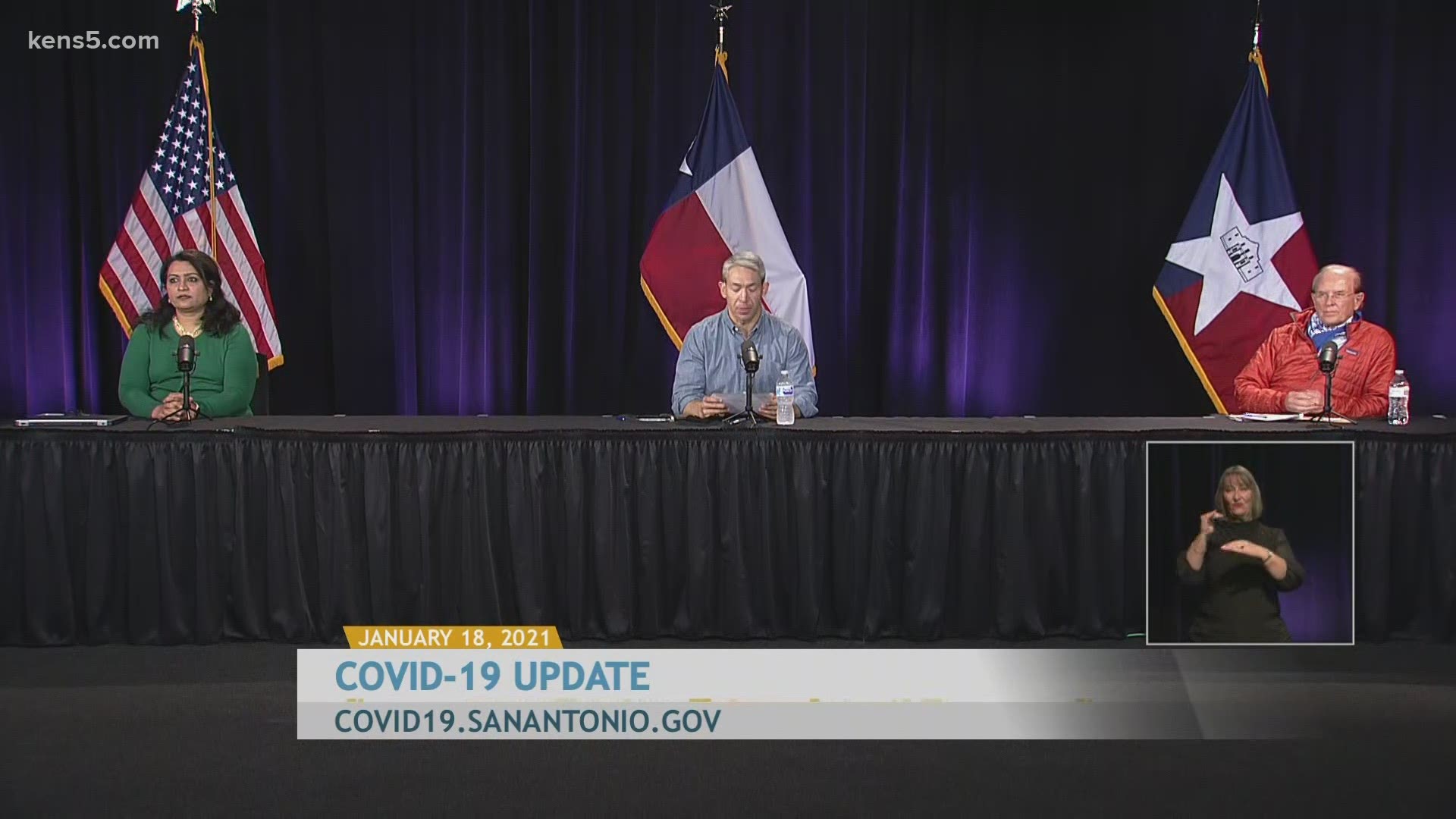SAN ANTONIO — We're tracking the latest numbers from the coronavirus pandemic in San Antonio and across Texas. Here are the latest numbers reported by Bexar and surrounding counties:
- Bexar County: On Monday, 1,281 new cases were reported, bringing the total number of cases to 149,836. Three new deaths were also reported, raising the local death toll to 1,812.
- Hays County: Hays County did not report new numbers Monday. On Friday, officials reported 139 new cases in the county and six additional COVID-related fatalities. As of Friday, there are a total of 12,948 lab-confirmed local cases, while the death toll rose to 154. Officials estimate 10,434 residents have recovered, while 2,360 are still ill with the virus.
- Comal County: Comal County did not report new numbers Monday. On Friday, officials reported 97 new cases and five additional COVID-related fatalities. There are a total of 7,245 cases, including 4,131 confirmed and 3,101 probable cases, while 201 county residents have died due to COVID-19 complications. The county estimates 6,213 residents have recovered, while 831 are still ill with the virus.
More county case information is available through the Texas Department of Health Services COVID-19 dashboard.
How Bexar County is trending
We've tracked how many coronavirus cases have been confirmed in Bexar County from the time officials began reporting cases in March 2020. The graphic below shows the number of cases since June and charts those daily case numbers along a 7-day moving average to provide a more accurate picture of the overall coronavirus case curve in our area and the direction we're trending amid the pandemic.
Mayor Ron Nirenberg reported an additional 1,281 cases on Monday for a total of 149,836 local infections since the pandemic began. The seven-day moving average dropped slightly from 2,071 on Sunday to 2,028 on Monday.


Nirenberg also reported three new deaths from virus complications, raising the local death toll to 1,812.
For the third day in a row, coronavirus-related hospitalizations increased at Bexar County facilities. On Monday, 1,520 patients were receiving treatment for COVID-19 symptoms, which is 82 more overall compared to Sunday.
Monday marks the first time more than 1,500 patients were concurrently receiving treatment for the coronavirus at area hospitals. 437 patients are in the ICU, one short of the record high for patients in intensive care, while 260 patients are on ventilators.


Coronavirus in Texas
The total number of novel coronavirus cases in the state since the pandemic began grew by 11,590 on Monday, according to the Texas Department of State Health Services. That total includes 10,110 new confirmed cases, 695 new probable cases, and 785 cases attributed to backlogs not previously reported in the state's total (more details can be found at the top of this page).
Monday's figures bring the total number of Texans diagnosed with COVID-19 to 2.125 million.


State health authorities also reported 46 additional virus-related deaths on Monday. At least 32,084 Texans have now died from COVID-19 complications.
Following two straight days of falling hospital numbers, the number of Texans receiving treatment at hospitals for coronavirus symptoms rose by 138 overall patients. On Monday, the concurrent total stood at 13,858.
The state estimates that about 1.697 million Texans have recovered, while 380,792 Texans remain ill with COVID-19.
The latest update from the Texas Education Agency showed that there have been at least 118,939 cumulative cases among staff and students across the state through January 10. That number comprises 74,277 positive student cases and 44,662 staff cases. More information can be found here.
The TEA releases new data on school cases on Fridays.
Latest Coronavirus Headlines
Coronavirus symptoms
The symptoms of coronavirus can be similar to the flu or a bad cold. Symptoms include fever or chills, cough, shortness of breath or difficulty breathing, fatigue, muscle or body aches, headache, new loss of taste or smell sore throat, congestion or runny nose, nausea or vomiting, and diarrhea, according to the Centers for Disease Control.
Most healthy people will have mild symptoms. A study of more than 72,000 patients by the Centers for Disease Control in China showed 80 percent of the cases there were mild.
But infections can cause pneumonia, severe acute respiratory syndrome, kidney failure, and even death, according to the World Health Organization. Older people with underlying health conditions are most at risk.
Experts determined there was consistent evidence these conditions increase a person's risk, regardless of age:
- Chronic kidney disease
- COPD (chronic obstructive pulmonary disease)
- Obesity (BMI of 30 or higher)
- Immunocompromised state (weakened immune system) from solid organ transplant
- Serious heart conditions, such as heart failure, coronary artery disease, or cardiomyopathies
- Sickle cell disease
- Type 2 diabetes
The CDC believes symptoms may appear anywhere from two to 14 days after being exposed.
Human coronaviruses are usually spread...
- Between people who are in close contact with one another (within about 6 feet).
- Through respiratory droplets produced when an infected person coughs, sneezes or talks. These droplets can land in the mouths or noses of people who are nearby or possibly be inhaled into the lungs.
- Some recent studies have suggested that COVID-19 may be spread by people who are not showing symptoms.
Help stop the spread of coronavirus
- Stay home when you are sick.
- Eat and sleep separately from your family members
- Use different utensils and dishes
- Cover your cough or sneeze with your arm, not your hand.
- If you use a tissue, throw it in the trash.
Find a Testing Location
City officials recommend getting a COVID-19 test if you experience fever or chills, cough, shortness of breath or difficulty breathing, fatigue, muscle or body aches, headache, new loss of taste or smell, sore throat, congestion or runny nose, nausea or vomiting, or diarrhea.
San Antonio operates several no-cost testing locations, including two walk-up locations open Monday-Sunday from 10 a.m. until 2 p.m.:
Cuellar Community Center
5626 San Fernando St.
San Antonio, TX 78237
Ramirez Community Center
1011 Gillette Blvd.
San Antonio, TX 78224
Additionally, Freeman Coliseum offers drive-through no-cost testing from Monday through Sunday between 9 a.m. and 4 p.m. An appointment is required and can be made either online or by calling (833) 213-0643.
Here's a Testing Sites Locator to help you find the testing location closest to you in San Antonio.

